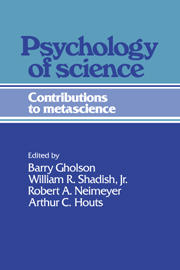Book contents
- Frontmatter
- Contents
- Preface
- Contributors
- 1 The psychology of science: An introduction
- Part I Historical issues in the psychology of science
- Part II The case for a psychology of science
- Part III Creativity and the psychology of science
- 7 Chance-configuration theory of scientific creativity
- 8 A perspectivist approach to the strategic planning of programmatic scientific research
- 9 Networks of enterprise in creative scientific work
- Part IV Cognition in the psychology of science
- Part V Social factors in the psychology of science
- Part VI Epilogue and Prologue
- Author index
- Subject index
7 - Chance-configuration theory of scientific creativity
Published online by Cambridge University Press: 05 June 2012
- Frontmatter
- Contents
- Preface
- Contributors
- 1 The psychology of science: An introduction
- Part I Historical issues in the psychology of science
- Part II The case for a psychology of science
- Part III Creativity and the psychology of science
- 7 Chance-configuration theory of scientific creativity
- 8 A perspectivist approach to the strategic planning of programmatic scientific research
- 9 Networks of enterprise in creative scientific work
- Part IV Cognition in the psychology of science
- Part V Social factors in the psychology of science
- Part VI Epilogue and Prologue
- Author index
- Subject index
Summary
Since the mid-1970s, I have been engaged in research on exceptional personal influence, attempting to determine why certain individuals have an inordinate and enduring impact on others in a given domain of achievement (Simonton, 1984c, 1987c). For the most part, this compelling interest has taken the form of historiometric studies of “geniuses,” of eminent creators and leaders, with a considerable portion of this work focusing on scientific creativity. During the course of this research, I have spotted a consistent theme pervading the phenomenon of scientific creativity, a theme now in the process of development into a full-fledged theory. I style this explanatory and interpretive framework the “chance-configuration” theory. I begin by sketching the chief tenets of this theory. The bulk of the chapter is then devoted to an empirical development of the basic ideas (for further theoretical details and empirical documentation, see Simonton, 1988).
The theory
My theoretical outlook takes its start with Donald Campbell's (1960) blindvariation and selective-retention model of creative thought. Campbell's model purports to be rather general, applicable to virtually any variety of knowledge acquisition or environmental adaptation, including biological evolution by natural selection, trial-and-error learning, creative thought, and social evolution (Campbell, 1960, 1965). Furthermore, the scheme has provided the basis for his “evolutionary epistemology,” a descriptive theory of knowledge (Campbell, 1974a). Campbell's position contains three core propositions:
The acquisition of new knowledge, the solution of novel problems, requires some means of producing variation.
[…]
- Type
- Chapter
- Information
- Psychology of ScienceContributions to Metascience, pp. 170 - 213Publisher: Cambridge University PressPrint publication year: 1989
- 27
- Cited by



